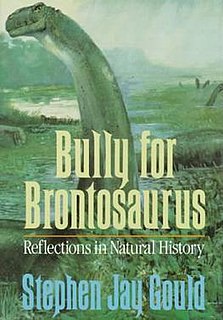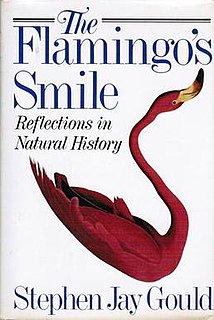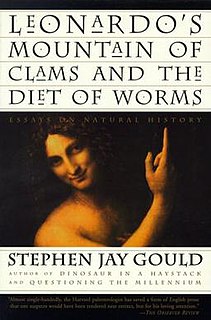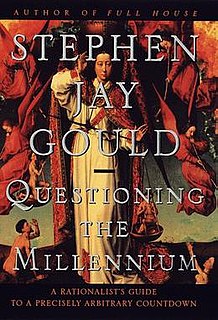 W
WBully for Brontosaurus (1991) is the fifth volume of collected essays by the Harvard paleontologist Stephen Jay Gould. The essays were culled from his monthly column "This View of Life" in Natural History magazine, to which Gould contributed for 27 years. The book deals, in typically discursive fashion, with themes familiar to Gould's writing: evolution and its teaching, science biography, and probabilities.
 W
WDinosaur in a Haystack is a 1995 book by the paleontologist Stephen Jay Gould. It collects essays culled from Gould's monthly column "The View of Life" published in Natural History magazine, which Gould contributed for 27 years. The book deals with themes familiar to Gould's writing: evolution, science biography, probabilities, and strange oddities found in nature.
 W
WEight Little Piggies (1993) is the sixth volume of collected essays by the Harvard paleontologist Stephen Jay Gould. The essays were selected from his monthly column "The View of Life" in Natural History magazine, to which Gould contributed for 27 years. The book deals, in typically discursive fashion, with themes familiar to Gould's writing: evolution and its teaching, science biography, probabilities and common sense.
 W
WEver Since Darwin is a 1977 book by the paleontologist Stephen Jay Gould. Gould's first book of collected essays, it originated from his monthly column "This View of Life," published in Natural History magazine. Edwin Barber—who was then the editorial director for W. W. Norton & Company— encouraged Gould to produce a book. He soon commissioned Gould to write The Mismeasure of Man, but it was not until three years later, when Gould accumulated 33 columns, that it occurred to either of them that the Natural History columns should be published in a single volume. The collection of essays, written between 1973–1977, became a best-seller and propelled Gould to national prominence.
 W
WThe Flamingo's Smile: Reflections in Natural History, published in 1985, is the fourth volume of collected essays from evolutionary biologist and well-known science writer Stephen Jay Gould; the essays were culled from his monthly column The View of Life in Natural History magazine, to which Gould contributed for more than two decades. The book deals, in typically discursive fashion, with themes familiar to Gould's writing: evolution and its teaching, science biography, probabilities and common sense.
 W
WFull House: The Spread of Excellence from Plato to Darwin is a 1996 book by evolutionary biologist Stephen Jay Gould. It was released in the United Kingdom as Life's Grandeur, with the same subtitle and with an additional eight-page introduction entitled "A Baseball Primer for British Readers".
 W
WThe Hedgehog, the Fox, and the Magister's Pox (2003) is Stephen Jay Gould's posthumous volume exploring the historically complex relationship between the sciences and the humanities in a scholarly discourse.
 W
WHen's Teeth and Horse's Toes (1983) is Stephen Jay Gould's third volume of collected essays reprinted from his monthly columns for Natural History magazine titled "This view of life". Three essays appeared elsewhere. "Evolution as Fact and Theory" first appeared in Discover magazine in May 1981; "Phyletic size decrease in Hershey bars" appeared in C. J. Rubins's Junk Food, 1980; and his "Reply to critics", was written specifically for this volume as a commentary upon criticism of essay 16, "The Piltdown Conspiracy".
 W
WI Have Landed (2002) is the 10th and final volume of collected essays by the Harvard paleontologist Stephen Jay Gould. The essays were culled from his monthly column "This View of Life" in Natural History magazine, to which Gould contributed for 27 years. The book deals, in typically discursive fashion, with themes familiar to Gould's writing: evolution and its teaching, science biography, probabilities and common sense.
 W
WLeonardo's Mountain of Clams and the Diet of Worms (1998) is the eighth volume of collected essays by the Harvard paleontologist Stephen Jay Gould. The essays were culled from his monthly column "The View of Life" in Natural History magazine, to which Gould contributed for 27 years. The book deals, in typically discursive fashion, with themes familiar to Gould's writing: evolution and its teaching, science biography, probabilities and common sense.
 W
WThe Lying Stones of Marrakech (2000) is the ninth volume of collected essays by the Harvard paleontologist, Stephen Jay Gould. The essays were culled from his monthly column "The View of Life" in Natural History magazine, to which Gould contributed for 27 years. The book deals with themes familiar to Gould's writing: evolution and its teaching, science biography, probability, and iconoclasm.
 W
WThe Mismeasure of Man is a 1981 book by paleontologist Stephen Jay Gould. The book is both a history and critique of the statistical methods and cultural motivations underlying biological determinism, the belief that “the social and economic differences between human groups—primarily races, classes, and sexes—arise from inherited, inborn distinctions and that society, in this sense, is an accurate reflection of biology”.
 W
WOntogeny and Phylogeny is a 1977 book on evolution by Stephen Jay Gould, in which the author explores the relationship between embryonic development (ontogeny) and biological evolution (phylogeny). Unlike his many popular books of essays, it was a technical book, and over the following decades it was influential in stimulating research into heterochrony, changes in the timing of embryonic development, which had been neglected since Ernst Haeckel's theory that ontogeny recapitulates phylogeny had been largely discredited.
 W
WThe Panda's Thumb: More Reflections in Natural History (1980) is a collection of 31 essays by the Harvard University paleontologist Stephen Jay Gould. It is the second volume culled from his 27-year monthly column "This View of Life" in Natural History magazine. Recurring themes of the essays are evolution and its teaching, science biography, probabilities and common sense.
 W
WQuestioning the Millennium is a 1997 book by the paleontologist Stephen Jay Gould that deals with the definition and calculation of the millennium, and its meaning in Western culture. New York Times reviewer Robert Eisner described it as a "slim and attractive meditation," which touches upon calendrics, Biblical exegesis, millennial cults, and includes "a charming essay on a young autistic man whose amazing ability to calculate instantly which day of the week coincided with any date mentioned over many centuries". Gould reveals that this young man was his autistic son, Jesse.
 W
WRocks of Ages: Science and Religion in the Fullness of Life is a 1999 book about the relationship between science and religion by the Harvard paleontologist Stephen Jay Gould. First published by Ballantine Books, it was reprinted by Vintage Books. The book is a volume in the series, The Library of Contemporary Thought.
 W
WThe Structure of Evolutionary Theory (2002) is Harvard paleontologist Stephen Jay Gould's technical book on macroevolution and the historical development of evolutionary theory. The book was twenty years in the making, published just two months before Gould's death. Aimed primarily at professionals, the volume is divided into two parts. The first is a historical study of classical evolutionary thought, drawing extensively upon primary documents; the second is a constructive critique of the modern synthesis, and presents a case for an interpretation of biological evolution based largely on hierarchical selection, and the theory of punctuated equilibrium.
 W
WTime's Arrow, Time's Cycle: Myth and Metaphor in the Discovery of Geological Time is a 1987 history of geology by the paleontologist Stephen Jay Gould, in which the author offers a historical account of the conceptualization of Deep Time and uniformitarianism using the works of the English theologian Thomas Burnet, and the Scottish geologists James Hutton and Charles Lyell.
 W
WAn Urchin in the Storm is a 1987 essay collection from paleontologist and science writer Stephen Jay Gould.
 W
WWonderful Life: The Burgess Shale and the Nature of History is a 1989 book on the evolution of Cambrian fauna by Harvard paleontologist Stephen Jay Gould. The volume made The New York Times Best Seller list, was the 1991 winner of the Royal Society's Rhone-Poulenc Prize, the American Historical Association's Forkosch Award, and was a 1991 finalist for the Pulitzer Prize. Gould described his later book Full House (1996) as a companion volume to Wonderful Life.
 W
W W
W W
W W
W W
W W
W W
W W
W W
W W
W W
W W
W W
W W
W W
W W
W W
W W
W W
W W
W